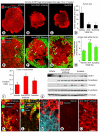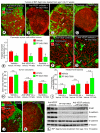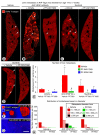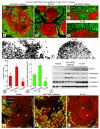Suppression of tumor invasion and metastasis by concurrent inhibition of c-Met and VEGF signaling in pancreatic neuroendocrine tumors
- PMID: 22585997
- PMCID: PMC3354652
- DOI: 10.1158/2159-8290.CD-11-0240
Suppression of tumor invasion and metastasis by concurrent inhibition of c-Met and VEGF signaling in pancreatic neuroendocrine tumors
Abstract
Invasion and metastasis increase after the inhibition of VEGF signaling in some preclinical tumor models. In the present study we asked whether selective VEGF inhibition is sufficient to increase invasion and metastasis and whether selective c-Met inhibition is sufficient to block this effect. Treatment of pancreatic neuroendocrine tumors in RIP-Tag2 mice with a neutralizing anti-VEGF antibody reduced tumor burden but increased tumor hypoxia, hypoxia-inducible factor-1α, and c-Met activation and also increased invasion and metastasis. However, invasion and metastasis were reduced by concurrent inhibition of c-Met by PF-04217903 or PF-02341066 (crizotinib). A similar benefit was found in orthotopic Panc-1 pancreatic carcinomas treated with sunitinib plus PF-04217903 and in RIP-Tag2 tumors treated with XL184 (cabozantinib), which simultaneously blocks VEGF and c-Met signaling. These findings document that invasion and metastasis are promoted by selective inhibition of VEGF signaling and can be reduced by the concurrent inhibition of c-Met.
Significance: This report examines the mechanism of increased tumor aggressiveness after anti-VEGF therapy and presents evidence for roles of vascular pruning, hypoxia, and c-Met activation. The results show that simultaneous inhibition of c-Met and VEGF signaling not only slows tumor growth but also reduces invasion and metastasis.
©2012 AACR.
Figures







Comment in
-
Anti-VEGF therapy revived by c-Met inhibition, but is c-Met the answer?Cancer Discov. 2012 Mar;2(3):211-3. doi: 10.1158/2159-8290.CD-12-0037. Cancer Discov. 2012. PMID: 22585992 Free PMC article.
References
-
- Ferrara N, Kerbel RS. Angiogenesis as a therapeutic target. Nature. 2005;438:967–74. - PubMed
-
- Ellis LM, Hicklin DJ. VEGF-targeted therapy: mechanisms of anti-tumour activity. Nat Rev Cancer. 2008;8:579–91. - PubMed
-
- Casanovas O, Hicklin DJ, Bergers G, Hanahan D. Drug resistance by evasion of antiangiogenic targeting of VEGF signaling in late-stage pancreatic islet tumors. Cancer Cell. 2005;8:299–309. - PubMed
Publication types
MeSH terms
Substances
Grants and funding
LinkOut - more resources
Full Text Sources
Other Literature Sources
Medical
Molecular Biology Databases
Miscellaneous

